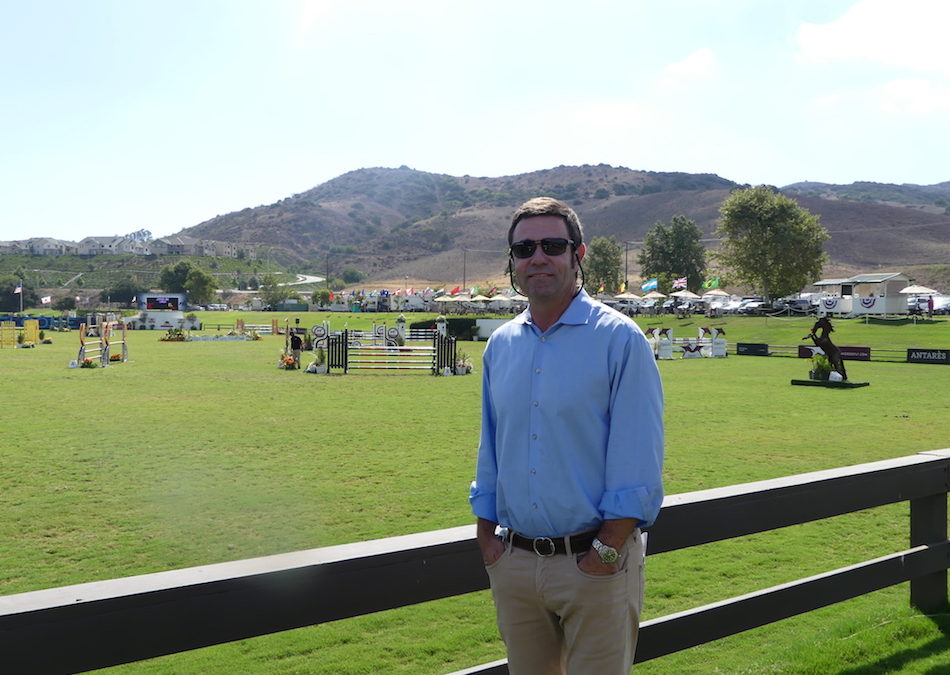Guilherme Jorge is a FEI Level 4 Course Designer who has built courses for international events across the globe, including the FEI World Cup™ Finals and Summer Olympic Games. Since his career began almost a quarter of a century ago, he has not only developed tracks for the top of the sport but for young horses and young riders as well. In 2013 Jorge was presented with the United States Hunter Jumper Association (USHJA) Lifetime Achievement Award.
He came to Southern California to create courses for the Blenheim June Classic 3. While he was here, he gave us some insight into his process when designing and told us about of a few of his favorite things about Blenheim.
How did you become interested in course design?
I rode up to Junior level back in Brazil in my hometown of Campinas which is close to São Paulo. Then I went to vet school and when I graduated as a vet, I started practicing with horses. I always loved the horses and wanted to be involved the sport, but I also found course designing very interesting and I started doing a little bit as a hobby. Then, I started getting more chances and getting more interested and at some point I had to choose and I decided to follow with the course design.
What are the challenges of designing for indoor vs outdoor?
When you build indoors you have to be a little bit more precise and make better use of the space you have. You don’t have as many options to build as you have in a big ring like this one [the Grand Prix field] here at Blenheim. But I think the basics are the same, you always have to find a nice track that allows the horses and riders to get a good rhythm. Myself, I like to work with scale so I get a good, accurate plan of the ring and then do the courses on scale. Of course, when you build indoors, since you have the space limitation, you really have to be accurate with your scale. But I think the basics are the same, you’re trying to get the best possible track, to get the best horse/rider combination as the winner, but without overdoing the other ones.
What are the advantages of designing on big grass fields such as these here at Blenheim?
If you have a grass field like this one that is very big and the footing is very good, it really lets you design whatever kind of track you want. It allows for a lot of good technical lines, you can do a line to a triple or a line to a double, or if we’re using the water jump, to the water jump. So here, you really have all the possibilities to put your imagination into.
What are some of your favorite ways to test horses and riders through your course design?
I think one of the things that I like to do more is to connect all the jumps. Even if they are not on a line or on a related distance from one jump to another, one sequence of jumps can make the next one ride easier or difficult so I like to test the balance of the riders, the rhythm they can get. I try to really connect the whole course from fence 1 to fence 13 even if they are not on a related distance.
What percentage of horse/rider combinations do you like to see make the jump off?
Well, I have a personal number that I like, that would be like 8. I don’t use the percentage that much. For me, that applies from a class from 20 to 50 horses, I would be happy. I think that 8 is a good number for the spectators, but also provides a challenging round so I like 8. But if I have to pick a percentage, you would want to be between 20-25% of the initial round.
You have designed courses at the top levels, do you have a favorite course you have ever done? If so, why?
No, it’s difficult to say. Like you said, I’ve been fortunate enough to design at big events and luckily I think they all worked out well in the end. I always have a good team and a good technical delegate from the FEI on those events. So, I don’t have one. Each were special in its own way, I don’t have one that I say “Okay this was my favorite one.”
How often do you come out to course design for Blenheim? What are some of your favorite things about coming to Southern California?
The first time I course designed here was in the year 2000, so we’re talking 18 years ago and I think I only missed one year working for Blenheim. But other than that, I’ve been coming here, to Showpark, or to Las Vegas once or twice a year. I think it’s a great facility, the ring is pretty, the footing is very good, we have good jumps, always good help, good jump crew. I think the weather here in San Juan Capistrano is the best that you can get. I have a very special relationship with Blenheim and with Robert and Stephanie because my first big break was the World Cup Finals back in 2005, then in 2007 again. I’m always very grateful for the opportunity that Blenheim EquiSports gave to me, so it’s always very special to come here.

